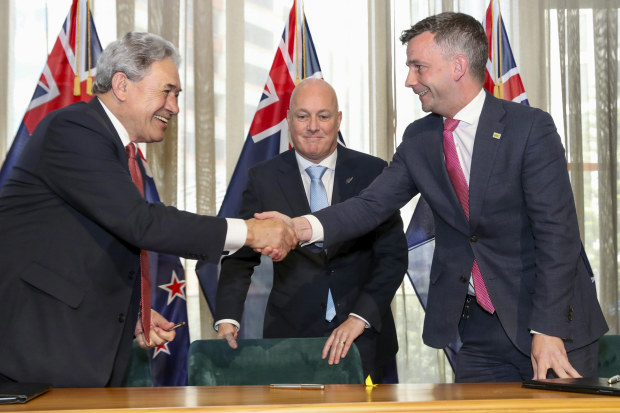Incoming NZ coalition targets central bank reform
Wellington | New Zealand’s National Party will form a centre-right government with two smaller partners for the first time in the country’s history, after finally reaching agreement on cabinet positions and policies that include changing the central bank’s mandate.
National will lead a three-way coalition with the libertarian ACT Party and the nationalist New Zealand First Party, the group announced in a statement on Friday. Cutting government spending, proceeding with tax cuts and returning the Reserve Bank to a sole focus on price stability will be key planks of the new government.

Prime Minister-elect Chris Luxon (centre) with coalition partners, New Zealand First leader Winston Peters (left) and ACT leader David Seymour at a signing ceremony. AP
The role of deputy prime minister, a key sticking point in lengthy discussions to form the government, will be split between political maverick Winston Peters and libertarian ACT leader David Seymour, the statement said.
National Party deputy leader Nicola Willis will be finance minister and Mr Peters, leader of NZ First, will be foreign minister, the parties said.
“The government will manage a strong economy that will ease the cost of living and deliver tax relief, restore law and order, deliver better public services and strengthen democracy,” Prime Minister-elect Chris Luxon said.
“It’s exciting to be on the cusp of delivering a big policy program with two coalition partners who, alongside National, are determined to make New Zealanders’ lives better.”
At the October 14 election, National won enough votes to oust the ruling Labour Party but not enough to hold a majority in parliament. Preliminary discussions to form a new government began soon after the vote, but negotiations became more intense once official results on November 3 showed National would need New Zealand First as well as ACT to govern.
Mr Peters will be deputy prime minister for the first half of the three-year term, with Mr Seymour filling the role for the second half. Mr Seymour will also be minister for regulation. The smaller parties will have three seats each in the 20-seat cabinet, under the agreement signed in Wellington.
100-day plan, 100-point economic plan
Mr Luxon said the agreement between National and its two partners “support the major elements of National’s policy program including our 100-day plan, our 100-point economic plan, and our tax and fiscal plans, with some adjustments”.
The deal confirms the National’s plan to remove the Reserve Bank’s dual mandate on inflation and employment, to focus monetary policy only on price stability. But it also says the government will take advice on replacing “medium term” with specific time targets for the bank when it is setting monetary policy.
The government will also take advice on removing the Treasury observer from the monetary policy committee and returning to a single decision-maker model, the agreement says.
“The Reserve Bank will be properly focused on doing the job it should have been doing for the past three years,” said Mr Seymour at a news conference following the announcement.
He said changes to the RBNZ’s legislation were a matter of “great urgency” but didn’t provide a timeframe.
National’s proposed tax cuts will proceed, but they will no longer be partly funded by allowing foreigners to purchase houses worth more than $NZ2 million ($1.8 million) and applying a levy to those transactions. Funding will instead come from a combination of new spending priorities and additional revenue measures.
The coalition parties have adopted ACT’s policy to speed up the rate at which interest deductibility for rental properties is restored, Mr Luxon said.
A new agency, accountable to Mr Seymour, will also assess the quality of new and existing regulation. This agency will be funded by disestablishing the Productivity Commission.
A Regional Infrastructure Fund proposed by New Zealand First will have $NZ1.2 billion in capital funding.
There will be five ministers from National, two from ACT and one from New Zealand First outside cabinet, while ACT and New Zealand First will each have one parliamentary under-secretary.
Historic coalition
While coalition governments are common under the proportional representation system that New Zealand adopted in 1996, it is the first time that three parties have entered into such an agreement. Mr Luxon described his coalition as “historic”.
New Zealanders turned to parties on the right of the political spectrum after growing frustrated with left-leaning Labour, the party of former prime minister Jacinda Ardern.
Ms Ardern won global praise for her leadership during the COVID-19 pandemic but her prolonged use of lockdowns and social restrictions became divisive, while Labour’s failure to deliver some of its promises also drew criticism.
Ms Ardern stood down in January and her successor Chris Hipkins walked back some of her policies, but it was not enough to turn the tide and win Labour a third term.
Bloomberg and Reuters
Introducing your Newsfeed
Follow the topics, people and companies that matter to you.
Find out moreRead More
Latest In Oceania
Fetching latest articles